
Great Horned Owl adult
Nicknamed the “feathered tiger,” the Great Horned Owl is one of the fiercest birds in the world. Females weigh less than 4 pounds and males less than 3, but they often tackle huge prey, including herons, ducks and geese, and large rabbits and hares. They also hunt tiny mice and frogs and large insects, spiders, and scorpions. Despite their powerful talons and killing ways, Great Horned Owls are surprisingly tender with mates and their young.

Great Horned Owl adult
On Valentine’s Day, when other birds’ hormonal levels are at their lowest, Great Horned Owls in the northern states are courting and even starting to lay eggs. They’ve been nesting since December or January in the South, and even late November in southern Florida. This unusually early breeding means extra time for the owlets to learn to hunt and catch prey.
Once he locates a likely nest site, the male hoots to initiate courting. The site is usually an abandoned Red-tailed Hawk or raven nest, but he may select a tree snag, rotted-out cavity, artificial platform, stick nest in a Great Blue Heron colony, or even a hay loft.
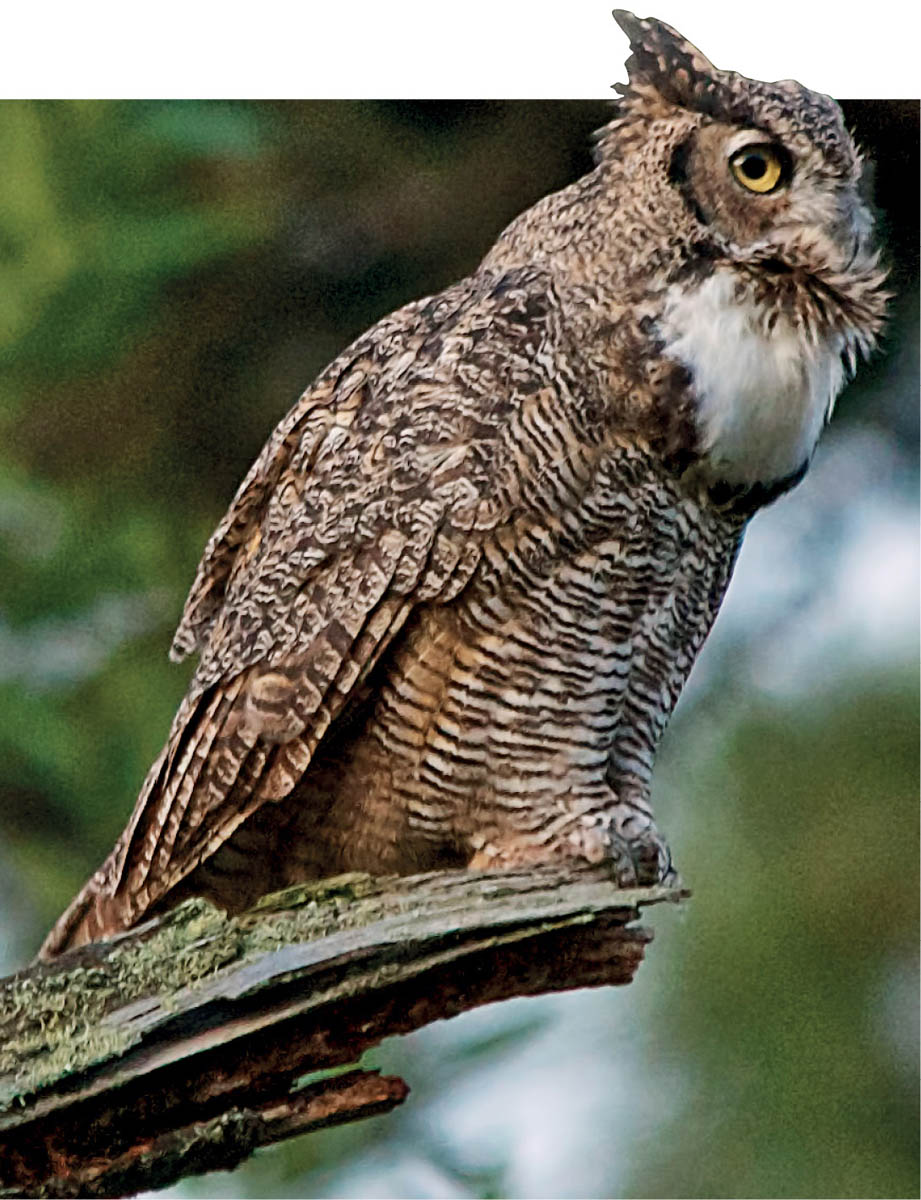
The raised feathers on this Great Horned Owl’s throat indicate that it is calling. Males establish and defend territories by giving a sequence of deep soft hoots, sounding like hoo, hoohoo, hoo, hoo and often translated as “Who’s awake? Me, too!”
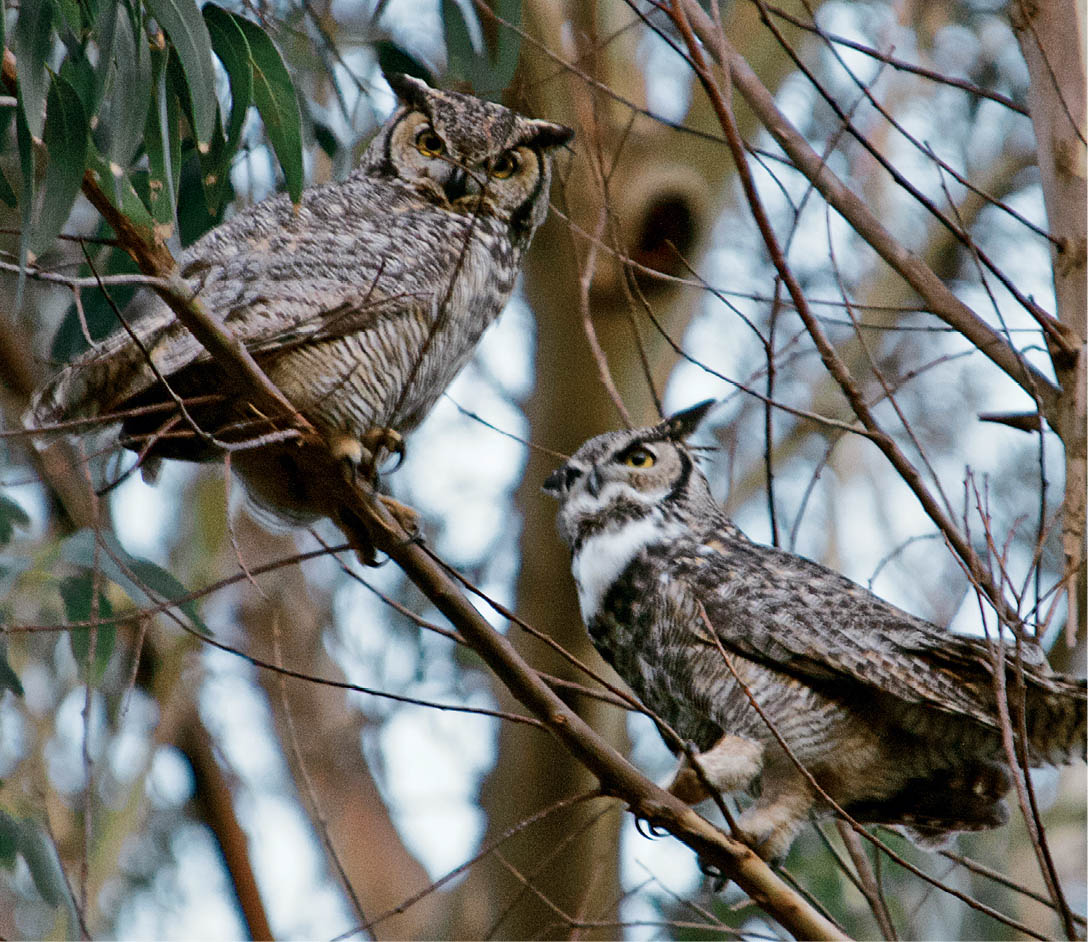
The courting male Great Horned Owl approaches the female with his white bib feathers fluffed out, bowing and bobbing his tail and extending his wings. He calls to her from potential nest sites, and she calls back.
Territorial hooting begins very early in the year, sometimes even in late autumn. Several weeks before egg-laying, the pair starts hooting back and forth together in duets, sometimes lasting an hour. The female’s voice is higher-pitched than her mate’s. Females are significantly larger than males but the males have a larger skull width, which may be why their voices are deeper. Males often hoot very close to the nest.
Courtship escalates as the male calls more frequently (averaging 2.7 calls per minute). Suddenly the female flies to a high perch in a nearby tree, and within a minute the male follows. As they mate, the male flaps his wings to maintain his balance on her back, his beak nuzzling feathers on her nape. Both continue hooting throughout copulation, which lasts four to seven seconds.
The duets and synchronized courtship behaviors may keep both birds fully focused on mating, to prevent injuries from their powerful, sharp talons and bill. The pair bond between two Great Horned Owls can last several years, probably for life, which expedites the courtship process in future years.
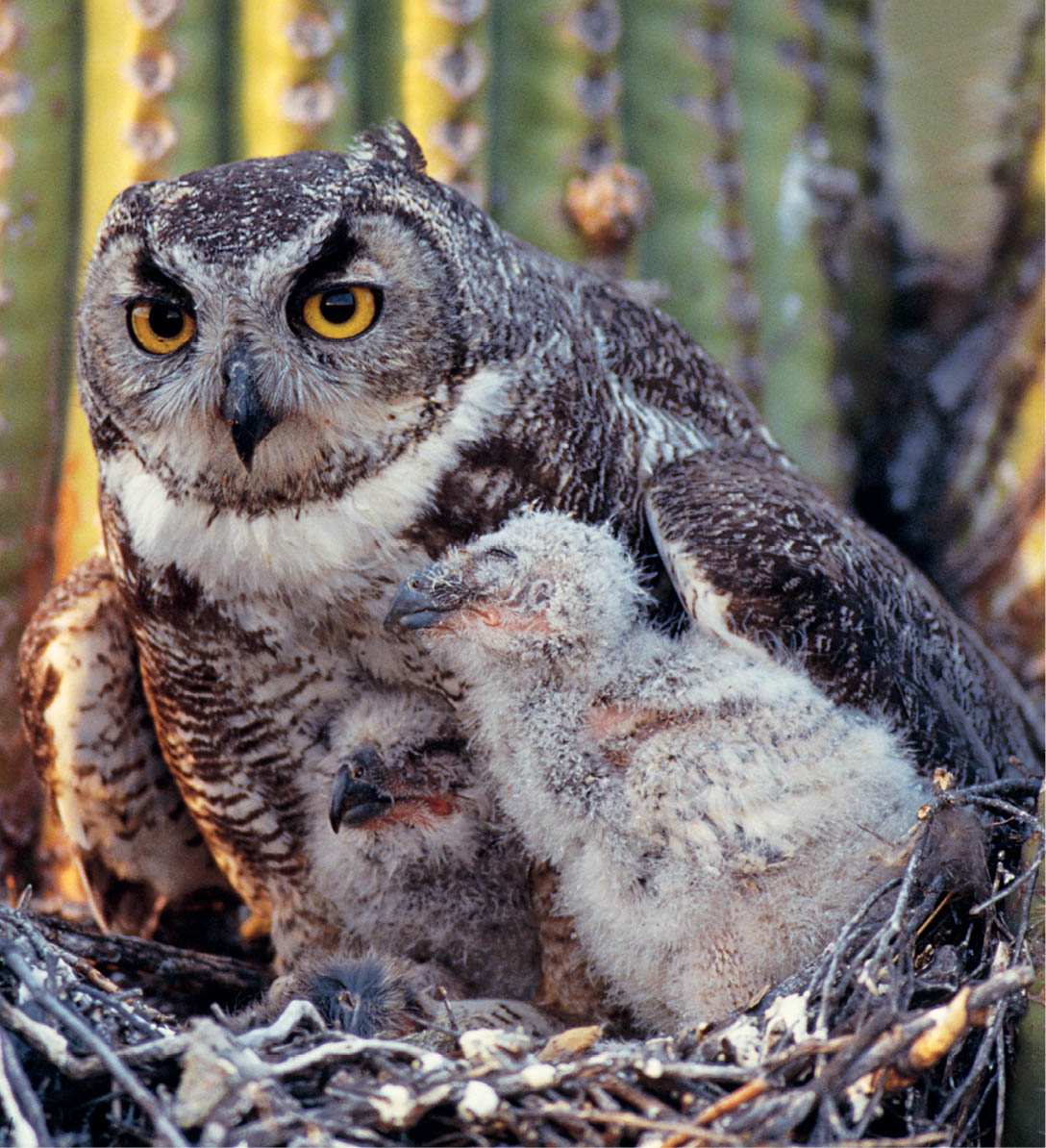
Two recently hatched Great Horned Owl nestlings with their mother in a nest in a saguaro cactus. Young owls are altricial, hatching covered with white down. Their eyes remain closed until nine to eleven days of age, and they are brooded by their mother for the first two weeks after hatching.
The female owl rarely leaves her nest during the early phase of incubation. Later, she’ll depart for longer periods to hunt, and when she returns, the round white eggs are easy for her to spot in low light.
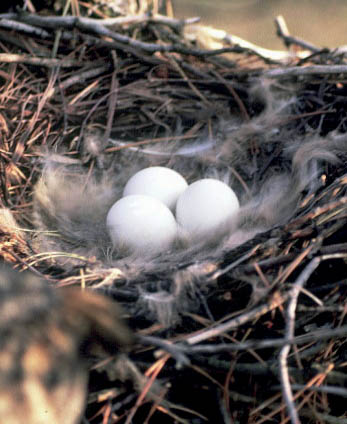
2 weeks old. This female is brooding one of her nestlings under her wing. This nest is in a window planter outside of a church in Arizona, where Great Horned Owls have nested nearly every year for 26 years.

3 weeks old. The same owlets now have more barred body plumage and the first feathers that will become the “horns.” The slightly downier one in front was probably the last hatched of the brood.
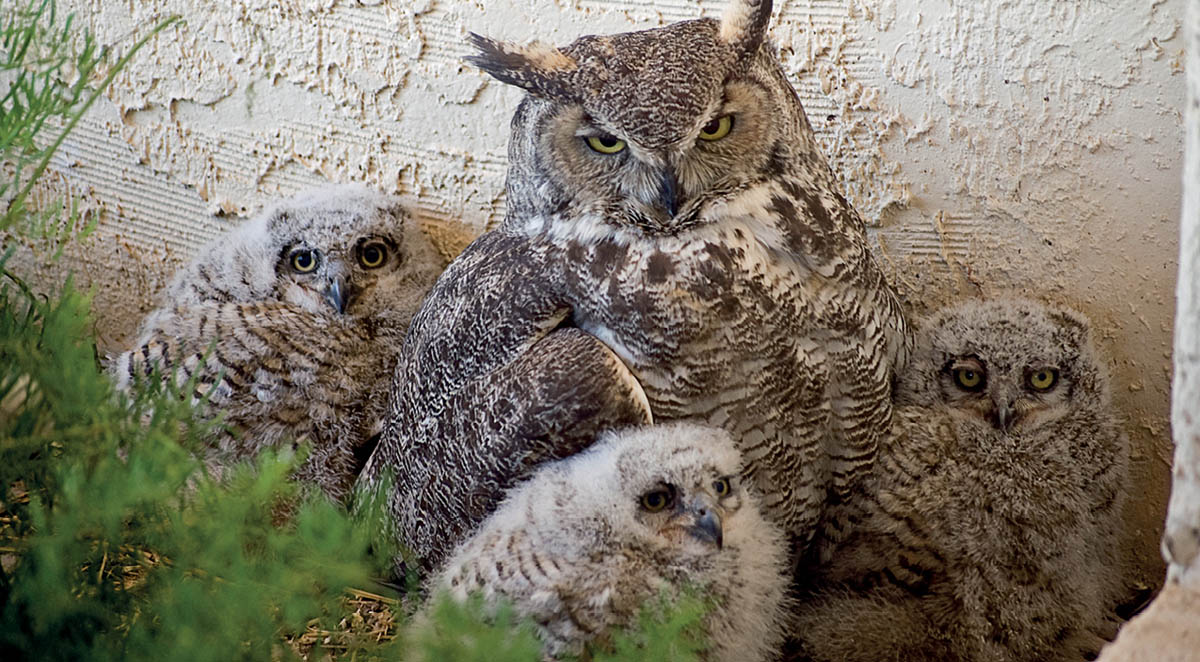
4 weeks old. With its mother in their nest in a coniferous tree, a Great Horned Owl nestling hisses and snaps at an approaching intruder. By now it can feed itself with prey brought by the adults, although its mother may continue to tear larger prey and feed it in small pieces for another week or so.

Established pairs often roost near one another, and frequently nuzzle and preen each other’s facial feathers. This allopreening is typical of many owls, unlike most other birds of prey.
Great Horned Owls lay their eggs in winter, and females start incubating after laying the first egg. Air temperatures may be lower than –25°F (–31.7°C), but the mother owl keeps the eggs at a full 98°F (36.6°C). The eggs start cooling as soon as she leaves the nest, but they are surprisingly hardy. One scientist observed a female leaving her nest for 20 minutes (to help her mate hoot at a neighboring male) when the temperature was –13°F (–25.0°C), yet the eggs all hatched. Usually she’s off the nest for only a few minutes at a time; her mate brings all her food.

A large owlet exercises its wings on a broken saguaro arm above its nest. The young can climb well by 40 days old and often clamber out along a tree branch or a ledge (hence they are called branchers). Their feet are specially adapted for this: one of their three forward-facing toes is opposable, like the human thumb. Owlets are fully feathered and can fly short distances when about 45 to 49 days old.
Incubation lasts on average 33 days. The eggs hatch about two days apart, probably in the order in which they were laid. The female usually broods them almost continuously for at least the first two weeks. The bare skin of her brood patch transfers her body heat to the eggs and chicks, holding their temperature at about 98°F (37°C).
She will gradually taper off brooding, except in northern areas or during cold or inclement weather. When she returns to the nest, she carefully covers the young and makes a soft hut-hut-hut call to which the young respond with faint whimpers. The vocal interplay probably helps ensure that she doesn’t hurt any of them as she eases herself down on them in the dark.
The nestlings grow rapidly, and the first to hatch has almost tripled its weight before the second hatches. Assertive, larger chicks may grab the lion’s share, even as the mother is feeding the smaller ones. Occasionally when food is scarce, the oldest chicks may kill and eat the smallest.
The white down of newly hatched chicks turns into grayish or yellowish plumage, still thick and downy, in eight days, and the future ear tufts are obvious patches by three weeks. By 11 weeks, the nestlings have clearly defined facial discs and white bibs.
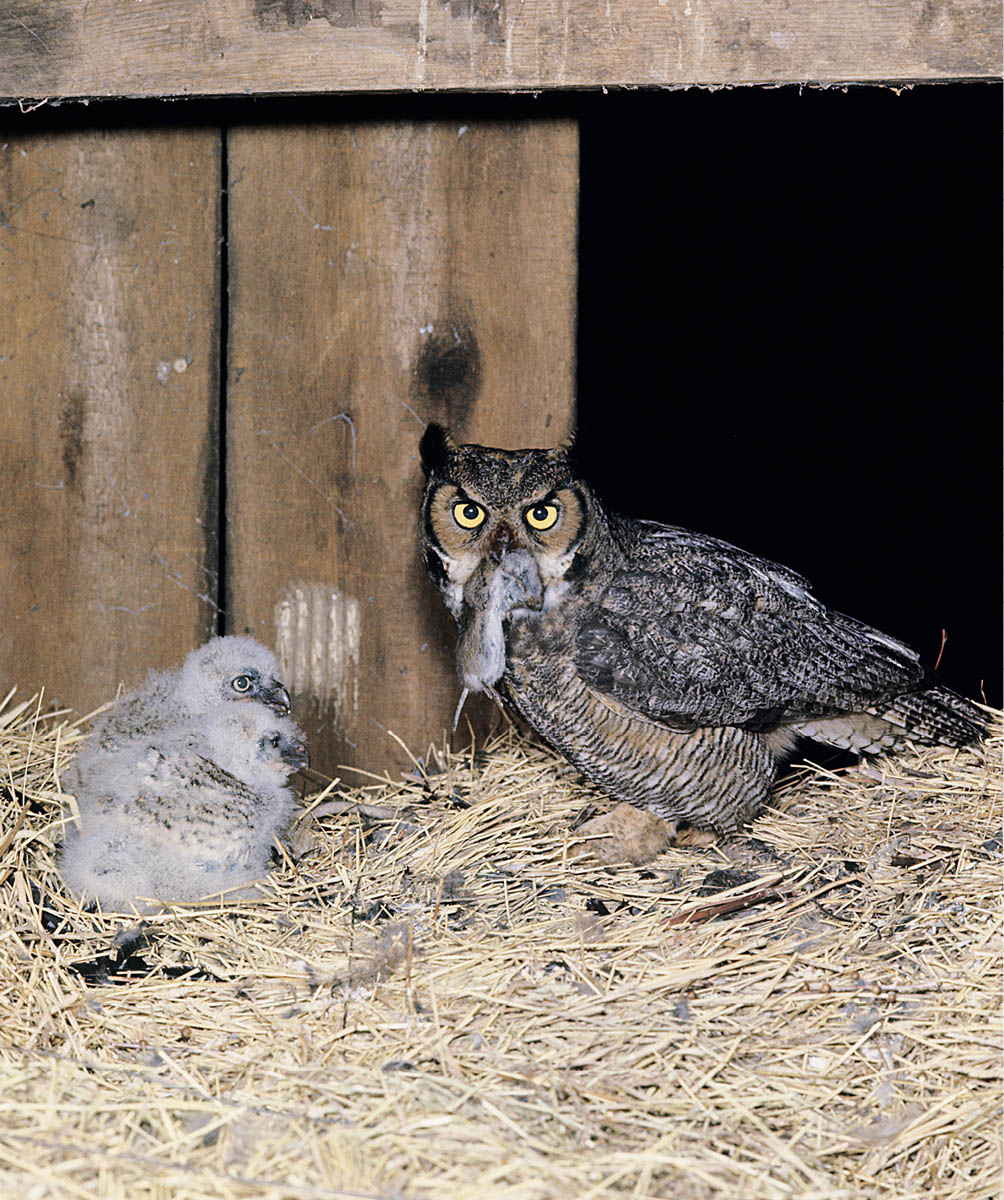
A Great Horned Owl brings a meadow vole to feed its two owlets in a nest on bales of straw in a barn. At first the male brings all the food and the female tears it into pieces for the young. If he doesn’t bring enough food as the young grow more demanding, she may leave the nest to hunt as well.

At first, fledglings stay close together, often roosting in the same tree, apart from their parents. They give begging calls while flying after the adults, who leave prey for them to dismember, even into September, when Great Horned Owl chicks almost everywhere are close to six months old.
The owlets make their first weak flights soon after branching. By fall, their area of exploration has expanded greatly, and eventually they disperse altogether from where they hatched.
Soon after the young disperse, adult males start territorial hooting. This probably helps discourage displaced adult males and inexperienced, soon-to-be-breeding males from moving onto their territories. Females take the lead in banishing any females from the territory.
It may take young owls several years before they are strong and experienced enough to claim and defend their own territory, so most owls don’t breed until they’re two years old or older.